Some of the shells featured in this photograph (flat edge) may be the Common Coquina, Donax variabilis measuring .5 to .75", and found from Virginia to South Florida, to Texas.
The two rounded edge shells, are unclear in identification, but may be the Atlantic Surf Clam, located throughout the Eastern U.S., and measuring up to 7" or, they may be the shell classed under Tellins and Semeles, as "Alternate Tellin", Tellina Alternata, which measures 2-3" and found from North Carolina through Florida to the Gulf Coast.
Classed under Bivalves
Clam-shaped - coquinas (Donacidae)
Variable coquina Donax variabilis (Say (=D. rœmeri protracta Conrad)
Description: (1 inch) Small, elongate, triangular shell. Smooth exterior with ribbing at beak end of shells. Hinge teeth.
Color: Extremely variable coloration -- white, yellow, orange, pink, red and purple in solids, ringed or rayed patterns.
Habitat: Lives in the intertidal zone of sandy ocean beaches.
Range: New York to Texas.
Notes: Also called a Florida coquina, butterfly shell, wedge shell or pompano. Often seen along the tide line of sandy beaches, where waves continually uncover these shallowly buried clams and wash them farther up the beach. Each time the coquina is exposed, its small, muscular foot immediately emerges and stands the animal on end as it burrows down an inch or two into the wet sand. Coquinas can survive in dry sand for up to three days. They make a delicious broth.
Source: Seashells of North Carolina, North Carolina Sea Grant College Program

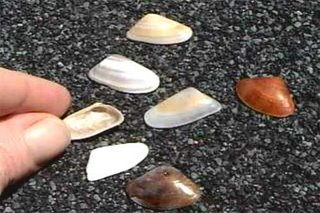
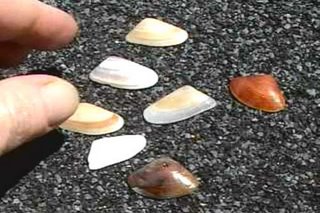


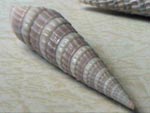

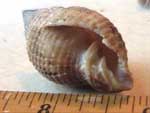





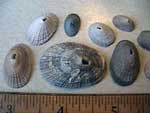

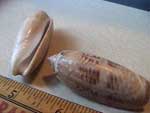
2 comments:
I have also been trying to identify shells like some you have pictured. The common coquina seems easy to identify with its more triangular shape and sometimes purple interior. However, the two darker ones you show are ones that I often collect, usually with the drilled holes and more striped colors. If you have found out their name, please post. Thank you!
Katie
Hi! I love coming to your site to see your pictures and learn a little something about the shells that I too have collected while strolling down the beach, but my question is this....Have you found any keyhole urchin,or "sand dollars", as most people call them, with coquina attached to it?
Post a Comment